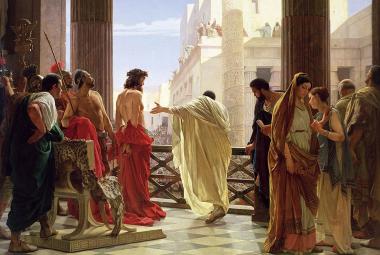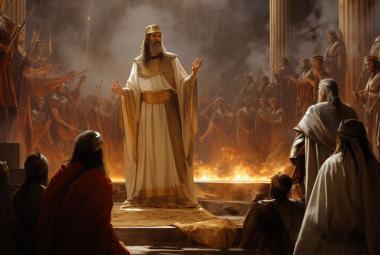The Second Epistle of John is among the most neglected books of the New Testament. It, like his third epistle, is simply a short personal letter from the Apostle. There is little doubt that the Apostle John was the author, but there are a number of conjectures as to whom it was written: someone called “the Elect Lady.”
(This article contains a conjecture that would seem to have no support from the extensive list of commentaries which have been consulted; however, bear with us and judge for yourself.)
The Recipient
The letter is addressed eklekte kuria, “the Elect Lady,” and her children. Kuria is a feminine proper name; but eklekte is a strange construction, never assigned to any other individual in the New Testament as a single predicate.[1] There are two prevailing views among the abundance of expositors:
(1) To the Church at large
Most commentators regard this as simply an idiom for the Church in a collective sense. And yet, the Church is never pictured as having children. In fact, the Church is always presented as a virgin[2] and as a bride.[3]
The view of kuria taken as a symbolic description of the Christian Church has been the dominant view as early as Jerome.[4] The view of believers as “children of the church” may have been comfortable for Jerome, et al., for ecclesiastical reasons, but it flies in the face of Scriptural usage: we are “children of God,” not “children of the church.” It is also significant that this word does not appear elsewhere with this signification.
The further allusion to the recipient’s sister and her children (v.13) would also seem fatal to this view but for the preponderance of the expositional history which has attended this epistle.
(2) To a prominent individual within the church
A straightforward reading of the letter would seem to indicate that the letter is addressed to some prominent member of the local church, and this has also been a common alternative interpretation.[5] The writer knows her sister and her sister’s children (v.13). This view would make this the only book in the Bible specifically addressed to a woman.
A Provocative Conjecture
Who would be the most “Elect Lady” in the entire Bible? To me, the most likely prima facie suggestion (which, however, is not even discussed among most commentators[6]) would be that the recipient of this intimate letter is the most “elect” of all women, the very one that Jesus Himself entrusted to John’s personal care: Mary, the mother of Jesus![7]
In fact, it is surprising that Jesus didn’t consign her to one of her other four sons. Jesus was raised among a family of at least seven: five brothers and two sisters.[8] James and Jude became believers after the resurrection and, in fact, each wrote the books in the New Testament that bear their names. Jesus appeared to James after His resurrection.[9] If our surmise is correct — and it is only a surmise — the others probably also became believers.[10]
And Mary did have a sister as alluded to in v.13.[11] We know so little of her subsequent history from the Scriptures; there are only minimal allusions in the Book of Acts.[12] She apparently remained in the care of John in his retirement in Ephesus.
Obviously, most of what is commonly published by the Roman Catholic Church has been contrived to promote a number of doctrinal heresies.[13] Most Biblical believers, from their revulsion to the tragic and heretical deification of Mary, tend to disregard her altogether and ignore her situation and predicament.
(We cannot miss the ostensibly dismissive allusion at her prompting during the wedding at Cana.[14])
“The Truth”
The “Elect Lady” is loved “by all they that have known the Truth”(v.1). Who else would be loved by all other believers? To whom else could this refer? This, too, seems to point to far more than simply a prominent personage within their local church!
Clearly, the prominence of “truth,” in concert with “love,” is the keynote of this letter. John uses the word “Truth” five times in the first four verses. He uses the word “love” four times. However, in this letter, we learn that Truth “dwells in us and shall be with us forever” (v. 2). “The Truth” may be intended as a more personal title.
Even Pilate’s cynical question still echoes in our ears, “What is Truth?” For believers, Jesus’ declaration is conclusive and comprehensive: “I am the Way, the Truth, and the Life.”[15]
It would seem that John is using, here, Truth as a title of Jesus Christ, just as he so often uses the Logos, the Word.[16] (The recipient of John’s letter also was not a latecomer: she was there “from the beginning.”[17]) If our suspicion is correct, it would place a unique complexion on the entire letter, and it would also yield a number of other significant insights.
We should not presume that any of us is beyond the need for encouragement or exhortation. Why would Mary — a blessed but human believer — be any exception? Especially during a time when widespread attacks on the deity of Jesus Christ was the topic of the day! Mary was subject to the same frailties as we are: pride, doubts, and a need of frequent encouragement, counsel, and, perhaps, exhortation. A tendency toward pride could certainly have been her most serious challenge: the most blessed of all women who had ever walked the earth! And yet, having to live with the clouds of legitimacy, and other doctrinal issues, over her firstborn.[18]
Read through the Second Epistle of John from Mary’s perspective, and see what the Spirit confirms to you.
Dating the Letter
On Paul’s return from his third missionary journey, he met with the Ephesian elders at Miletus (some 30 miles south of Ephesus) and delivered to them that touching farewell address in which he warned them of the forthcoming false teachers.[19] It was this subsequent rise of these false doctrines which is the focus of all three of John’s later epistles.
It would seem that II John was written to this very community, but at an earlier date than I John (since the false teachers, the “Gnostics,” evidently still had access to the church in II John, but had seceded from it in I John).[20] This conjecture concerning the identity of “the Elect Lady” would also imply that II John was written earlier than A.D. 85, since Mary would have been about a century old by then.
By the time that John is subsequently in exile on the isle of Patmos, Ephesus was prominent as the first of the seven churches in Revelation for which Jesus includes a report card. The church at Ephesus, by then, had apparently exercised effective diligence regarding false doctrine, but had “left their first love.”[21]
The apostle John, according to tradition, spent his final years in Ephesus, where he died and was buried.
The Key Lesson
In any case, John’s letters focus on our walking in love, in truth, and in the intimate knowledge of God. They deal with, in a sense, a challenge similar to the indictment by the Prophet Hosea:
Hear the word of the LORD, ye children of Israel: for the LORD hath a controversy with the inhabitants of the land, because there is no truth, nor mercy, nor knowledge of God in the land.
— Hosea 4:1
The issue in all three letters is that love and truth must be practiced, or “walked.” “To walk in the truth” means to obey it. It is easier to study the truth, or even argue about the truth, than it is to obey it. Knowing the truth is more than giving assent to a series of doctrines; it means that the believer’s life is controlled by a love for the truth and a desire to magnify the truth.
For a practical contemporary guide on this same subject, authored by my own personal “Elect Lady,” Walking in Love and Truth and Intimate Knowledge of God, by Nancy Missler, is a summary of her famous trilogy, The Way of Agape, Be Ye Transformed, and Faith in the Night Seasons.
Notes:
- Except in Romans 16:13, “chosen in the Lord.” ↩
- 2 Corinthians 11:2. ↩
- John 3:29; Revelation 18:23; 21:2, 9; 22:17; Cf. Ephesians 5:22–27. ↩
- Jerome (Ep. Xi. Ad Ageruchiam); later Calovius, Whiston, Michaelis, Augusti, Hofmann (Weissagung u. Erfllung , II. P.321, and Schriftbew., I. P.226ff); Hilgenfeld (1855), Ewald, Candlish, Barnes, Huther, etc. Also, more recently, R. W. Harris, H. I. Marshall, A. Plummer, Ray Stedman, Jerry Vines, J. Vernon McGee, Warren Wiersbe, John Walvoord, and other contemporary commentators. ↩
- John uses a plural in vv. 6, 8, 10, 12; and a singular in vv. 1, 4, 5, 13. The fact that he embraces others as well in passing doesn’t alter the intended addressee. The family of the “Elect Lady” is clearly in view. ↩
- So far, I haven’t found any that support the idea of Mary except Knauer (Stud. U. Krit., 1833, Part 2, p.452ff; q.v. J. E. Huther, Critical and Exegetical Handbook to the General Epistles of James, Peter, John, and Jude, translated from the German, 11 vols., Funk and Wagnalls, 1884). ↩
- John 19:26, 27. ↩
- Matthew 13:55, 56; Mark 6:3. ↩
- 1 Corinthians 15:7. ↩
- Cf. v. 4 (However, the Greek actually indicates “some of thy children” rather than all of them.) ↩
- John 19:25. ↩
- Acts 1:14. ↩
- See Dave Hunt’s A Woman Rides the Beast (Harvest House, Eugene OR, 1994) for a comprehensive, well-documented and timely review. ↩
- John 2:4. ↩
- John 14:6. ↩
- John 1:1–3, 14, 1 John 5:7, Revelation 19:13. ↩
- Cf. vv. 5 & 6. The “we” suggests a provocative joint identity with John. ↩
- John 8:41. ↩
- Acts 20:18–35. ↩
- 1 John 2:19. ↩
- Revelation 2:1–7. ↩






